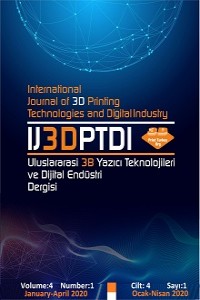Abstract
Çeşitli ısıl işlem uygulamaları ve üretim süreci ile döner çim biçme makinelerinin kesme bıçaklarının ömrünü uzatarak ekonomiye dikkate değer bir düzeyde katkıda bulunmak mümkündür. Döner makasların kesme bıçaklarının ömrünü uzatmak malzeme, enerji, zaman ve işçilik kayıplarından tasarruf sağlayacaktır. Bunlara ek olarak, aşınmış döner çim biçme makinesi kesme bıçaklarının kullanımı kesilmemiş çim bitkilerini hızlandıracak ve yakıt tüketimini artıracaktır. Bu çalışmada çim biçme makineleri için iki farklı tipte kesme bıçağının karakterizasyonu yapılmıştır. Kesme bıçaklarının mekanik özelliklerini ve kimyasal bileşimini bilmek, bıçakların nasıl üretildiğine ve çalışma koşullarında uygulanan kuvvetlere nasıl tepki verdiğine ilişkin bilgileri açıklar. Bu nedenle, üretim sürecinin reçetesi kolayca tanımlanabilir ve bıçakların çalışma koşullarında dayanıklılığı ve etkinliği tahmin edilebilir. Kesme bıçakları en çok değiştirilen parçadır ve genellikle kırıldığı, aşındığı ve büküldüğü için sarf malzemesi parçalarından biri olarak listelenir. Metallerin kimyasal bileşimi ve yapısı, ısı ve imalat işlemleri kesme bıçaklarının aşınmasını, mukavemetini, sertliğini ve dayanıklılığını etkiler. Numuneler, iki farklı kesme bıçağından Lazer Kesme Makinesi kullanılarak elde edildi. Malzemelerin mekanik ve kimyasal bileşimini araştırmak için birçok yöntem kullanılmıştır. Bu değerlendirmeler sertlik testi, SEM ve Mikroskopik görüntüleme şeklinde gerçekleştirildi. Tüm bu analizlerden elde edilen sonuçlar imalat sürecini optimize etmek için kullanılmıştır.
References
- Reference1. Weise, G., Bourarach, E. H., “Tillage machinery,” in: B. A. Stout (ed.), CIGR Handbook of Agricultural Engineering, Vol. III: Plant Production Engineering, ASAE, St. Joseph, MI, USA, 184-217, 1999. Reference2. Kanadyjski, C., Karwoski, T., “Agricultural machines, theory and construction”, Foreign Scientific Publications Department of The National Center for Scientific and Economic Information, Warsaw, Poland, vol. 2, 465-466, 1974. Reference3. National Research Council Canada, “A Strategy for Tribology in Canada”, 36-39, 1986. Reference4. Kushwaha, R. L., Shi, J., “Investigation of wear of agricultural tillage tools”, J. Soc. Tribol. Lubr. Eng., 47(3), 219-222, 1991. Reference5. Bernacki, H., “Grundlagen der Bodenbearbeitung und Pflugbau”, Berlin, 1967. Reference6. Dilmaç, M., “Toprak İşleme Aletlerinin Teori, Hesap ve Konstrüksiyonu”, Zonguldak, 1984. Reference7. Rostek, T., Homberg, W., "Grading technologies for the manufacture of innovative cutting blades", AIP Conference Proceedings 1960, 100013, 2018. Reference8. Amer N.N. Kakahya, D. Ahmadb, M.D. Akhirc, S. Sulaimand, A. Ishak., “Effects of Rotary Mower Blade Cutting Angles on the Pulverization of Sweet Potato Vine” Agriculture and Agricultural Science Procedia 2, 95-10, 2014. Reference9. Noor Mazni Ismail, Nurul Aida Amir Khatif, Mohamad Aliff Kamil Awang Kecik, Mohd Ali Hanafiah Shaharudin., “The effect of heat treatment on the hardness and impact properties of medium carbon steel” Materials Science and Engineering 114, 2016. Reference10. Steel Navigator, “55Cr3”, [article in English], https://steelnavigator.ovako.com/steel-grades/55cr3/, February 16, 2020.
Abstract
It is possible to contribute to the economy at a remarkable level by extending the life of the cutting blades for rotary slashers with various heat treatment applications and manufacturing process. Extending the life of the cutting blades of rotary slashers will save material, energy, time and labor losses. In addition to those, the use of worn rotary slasher cutting blades will accelerate the uncut grass-plants and increase fuel consumption. In this study, the characterization of two different types of cutting blades for rotary slashers was carried out. Knowing mechanical properties and chemical composition of cutting blades discloses the information regarding how the blades are manufactured and react to forces applied in working conditions. Therefore, the prescription of manufacturing process can be easily identified and endurance & effectiveness of blades in operating conditions can be predicted. The cutting blades are the most replaced part and listed as one of the consumable parts since they are often broken, worn and bended. The chemical composition and structure of the metals, heat & manufacturing processes affect the wear, strength, hardness, and durability of the cutting blades. The samples were obtained from two different cutting blades using Laser Cutting Machine. Many methods were used to investigate mechanical and chemical composition of the materials. These were hardness test, SEM and Microscopic imaging. The results obtained from all these analyses were used to optimize the manufacturing process.
References
- Reference1. Weise, G., Bourarach, E. H., “Tillage machinery,” in: B. A. Stout (ed.), CIGR Handbook of Agricultural Engineering, Vol. III: Plant Production Engineering, ASAE, St. Joseph, MI, USA, 184-217, 1999. Reference2. Kanadyjski, C., Karwoski, T., “Agricultural machines, theory and construction”, Foreign Scientific Publications Department of The National Center for Scientific and Economic Information, Warsaw, Poland, vol. 2, 465-466, 1974. Reference3. National Research Council Canada, “A Strategy for Tribology in Canada”, 36-39, 1986. Reference4. Kushwaha, R. L., Shi, J., “Investigation of wear of agricultural tillage tools”, J. Soc. Tribol. Lubr. Eng., 47(3), 219-222, 1991. Reference5. Bernacki, H., “Grundlagen der Bodenbearbeitung und Pflugbau”, Berlin, 1967. Reference6. Dilmaç, M., “Toprak İşleme Aletlerinin Teori, Hesap ve Konstrüksiyonu”, Zonguldak, 1984. Reference7. Rostek, T., Homberg, W., "Grading technologies for the manufacture of innovative cutting blades", AIP Conference Proceedings 1960, 100013, 2018. Reference8. Amer N.N. Kakahya, D. Ahmadb, M.D. Akhirc, S. Sulaimand, A. Ishak., “Effects of Rotary Mower Blade Cutting Angles on the Pulverization of Sweet Potato Vine” Agriculture and Agricultural Science Procedia 2, 95-10, 2014. Reference9. Noor Mazni Ismail, Nurul Aida Amir Khatif, Mohamad Aliff Kamil Awang Kecik, Mohd Ali Hanafiah Shaharudin., “The effect of heat treatment on the hardness and impact properties of medium carbon steel” Materials Science and Engineering 114, 2016. Reference10. Steel Navigator, “55Cr3”, [article in English], https://steelnavigator.ovako.com/steel-grades/55cr3/, February 16, 2020.
Details
| Primary Language | English |
|---|---|
| Subjects | Mechanical Engineering |
| Journal Section | Research Article |
| Authors | |
| Publication Date | April 30, 2020 |
| Submission Date | February 17, 2020 |
| Published in Issue | Year 2020 Volume: 4 Issue: 1 |
Cite
International Journal of 3D Printing Technologies and Digital Industry is lisenced under Creative Commons Atıf-GayriTicari 4.0 Uluslararası Lisansı


